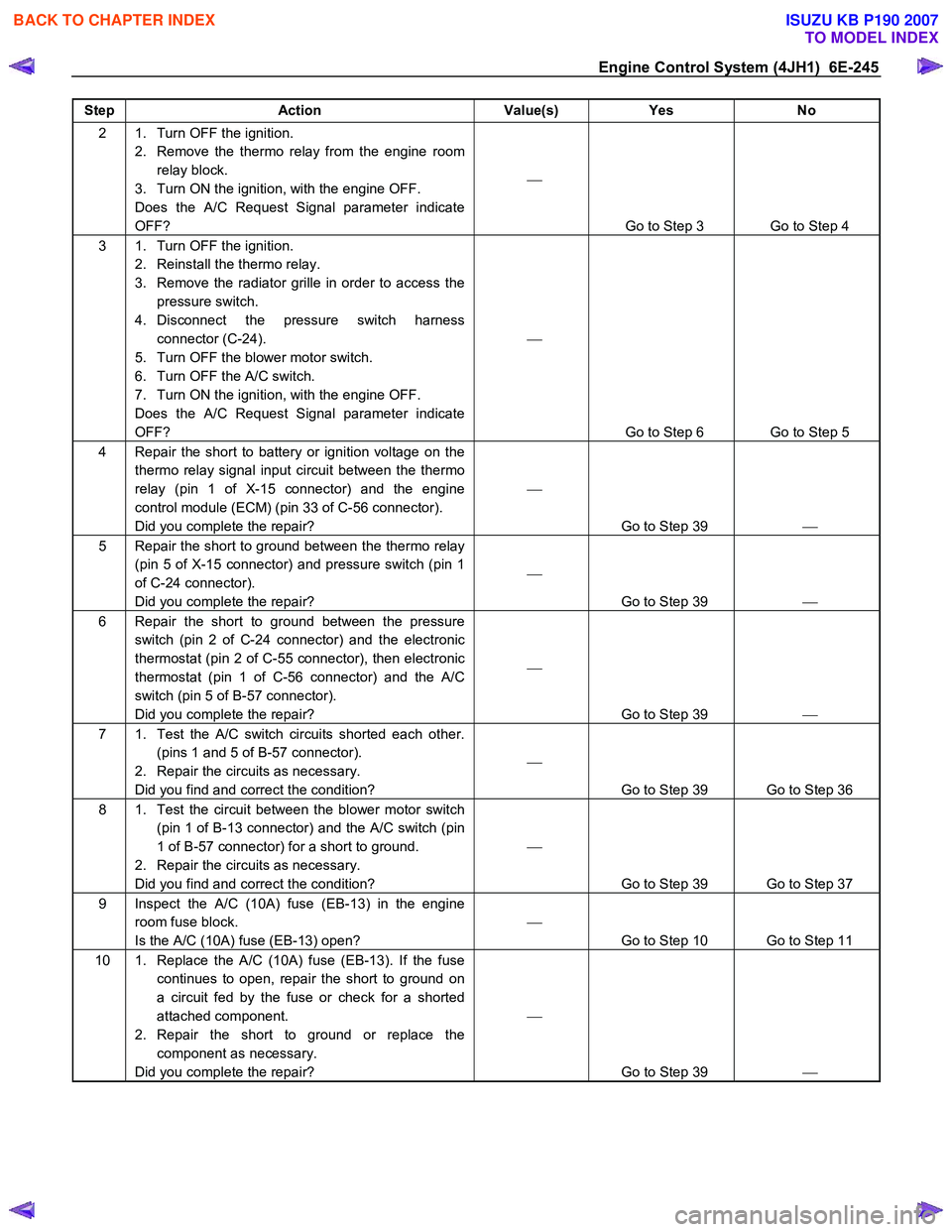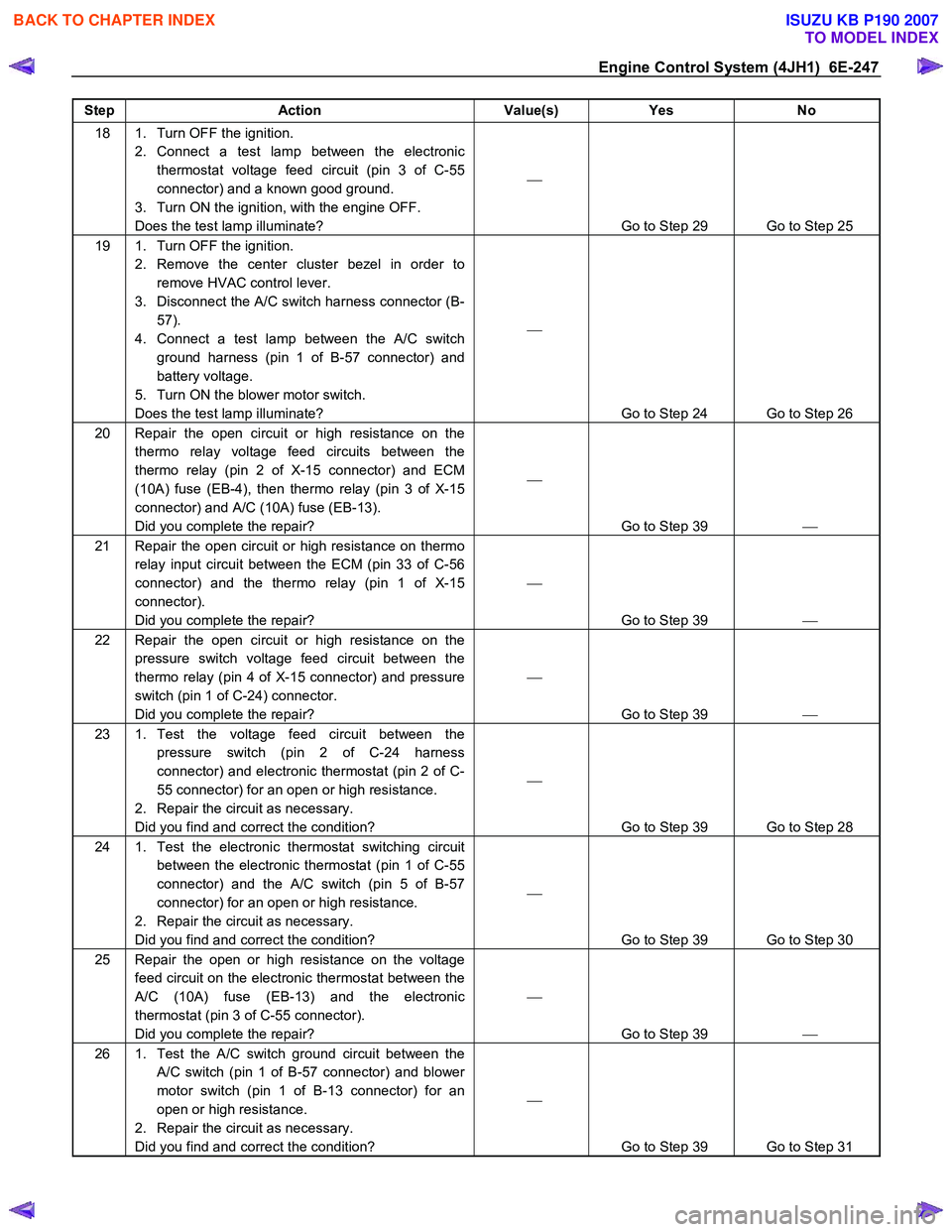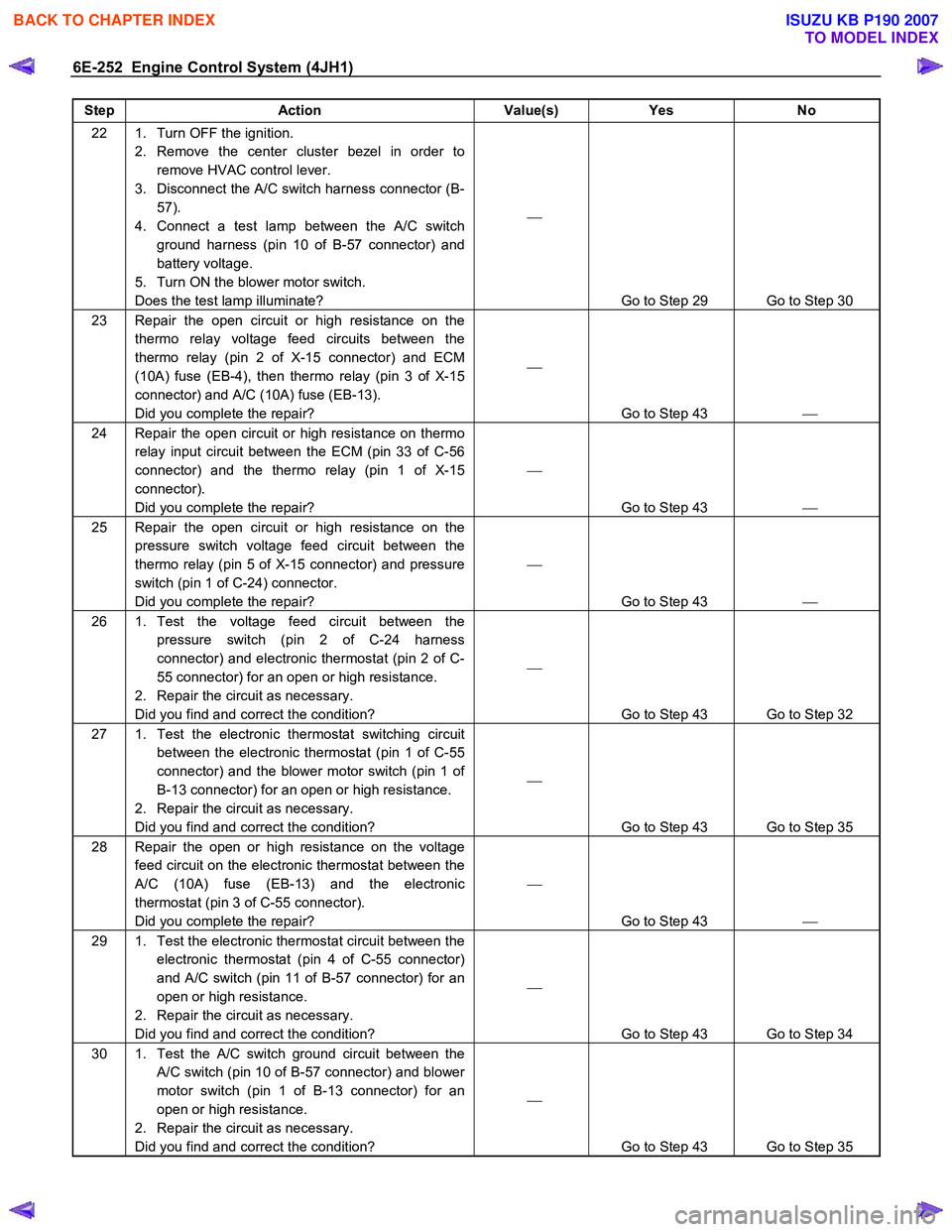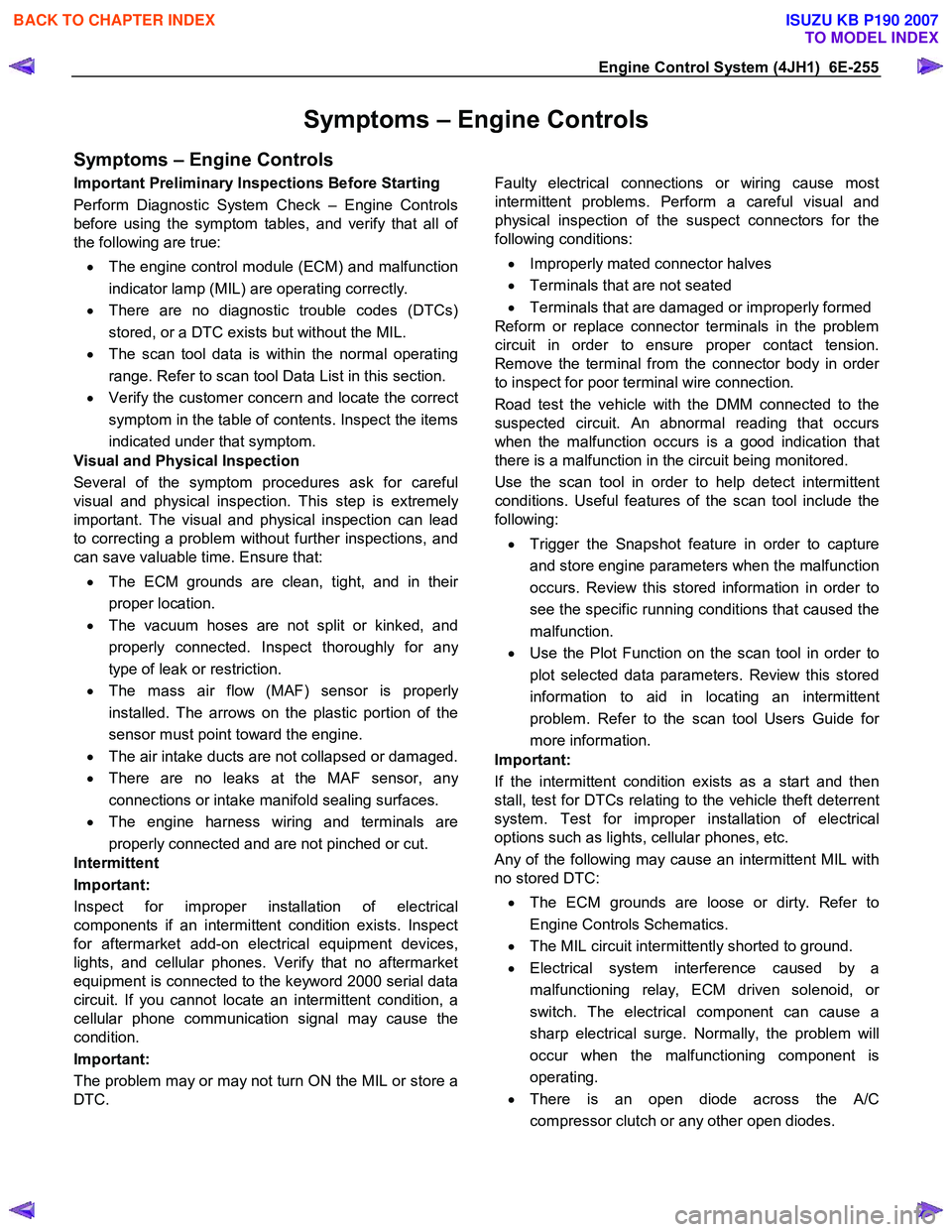2007 ISUZU KB P190 Circuit
[x] Cancel search: CircuitPage 1279 of 6020

Engine Control System (4JH1) 6E-245
Step Action Value(s) Yes No
2 1. Turn OFF the ignition.
2. Remove the thermo relay from the engine room relay block.
3. Turn ON the ignition, with the engine OFF.
Does the A/C Request Signal parameter indicate
OFF?
Go to Step 3 Go to Step 4
3 1. Turn OFF the ignition. 2. Reinstall the thermo relay.
3. Remove the radiator grille in order to access the pressure switch.
4. Disconnect the pressure switch harness connector (C-24).
5. Turn OFF the blower motor switch.
6. Turn OFF the A/C switch.
7. Turn ON the ignition, with the engine OFF.
Does the A/C Request Signal parameter indicate
OFF?
Go to Step 6 Go to Step 5
4 Repair the short to battery or ignition voltage on the thermo relay signal input circuit between the thermo
relay (pin 1 of X-15 connector) and the engine
control module (ECM) (pin 33 of C-56 connector).
Did you complete the repair?
Go to Step 39
5 Repair the short to ground between the thermo relay
(pin 5 of X-15 connector) and pressure switch (pin 1
of C-24 connector).
Did you complete the repair?
Go to Step 39
6 Repair the short to ground between the pressure
switch (pin 2 of C-24 connector) and the electronic
thermostat (pin 2 of C-55 connector), then electronic
thermostat (pin 1 of C-56 connector) and the A/C
switch (pin 5 of B-57 connector).
Did you complete the repair?
Go to Step 39
7 1. Test the A/C switch circuits shorted each other.
(pins 1 and 5 of B-57 connector).
2. Repair the circuits as necessary.
Did you find and correct the condition?
Go to Step 39 Go to Step 36
8 1. Test the circuit between the blower motor switch (pin 1 of B-13 connector) and the A/C switch (pin
1 of B-57 connector) for a short to ground.
2. Repair the circuits as necessary.
Did you find and correct the condition?
Go to Step 39 Go to Step 37
9 Inspect the A/C (10A) fuse (EB-13) in the engine room fuse block.
Is the A/C (10A) fuse (EB-13) open?
Go to Step 10 Go to Step 11
10 1. Replace the A/C (10A) fuse (EB-13). If the fuse continues to open, repair the short to ground on
a circuit fed by the fuse or check for a shorted
attached component.
2. Repair the short to ground or replace the component as necessary.
Did you complete the repair?
Go to Step 39
BACK TO CHAPTER INDEX
TO MODEL INDEX
ISUZU KB P190 2007
Page 1280 of 6020

6E-246 Engine Control System (4JH1)
Step Action Value(s) Yes No
11 1. Turn OFF the ignition.
2. Remove the thermo relay from the engine room relay block.
3. Connect a test lamp between the voltage feed circuit (pins 1 and 3 of X-15 connector) and a
known good ground.
4. Turn ON the ignition, with the engine OFF.
Does the test lamp illuminate on both circuits?
Go to Step 12 Go to Step 20
12 1. Turn OFF the ignition. 2. Reinstall the thermo relay.
3. Remove the radiator grille in order to access the pressure switch.
4. Disconnect the pressure switch harness connector (C-24).
5. Connect a 3-amp fused jumper wire between the pressure switch harness (pin 1 of C-24
connector) and a known good ground.
6. Turn ON the ignition, with the engine OFF.
Does the thermo relay click (engage)?
Go to Step 13 Go to Step 15
13 Does the A/C Request Signal Request parameter indicate ON?
Go to Step 16 Go to Step 14
14 1. Turn OFF the ignition.
2. Keep the 3-amp fused wire with connected.
3. Disconnect the ECM C-56 harness connector.
4. Connect a test lamp between the thermo relay input circuit (pin 33 of C-56 connector) and a
known good ground.
5. Turn ON the ignition, with the engine OFF. DO NOT START the engine.
Does the test lamp illuminate?
Go to Step 32 Go to Step 21
15 1. Turn OFF the ignition. 2. Keep the 3-amp fused wire with connected.
3. Replace the thermo relay with the horn relay or replace with a known good relay.
4. Connect a 3-amp fused jumper wire between the pressure switch harness (pin 1 of C-24
connector) and a known good ground.
5. Turn ON the ignition, with the engine OFF.
Does the thermo relay click (engage)?
Go to Step 27 Go to Step 22
16 1. Turn OFF the ignition. 2. Connect the pressure switch harness connector.
3. Remove the grove box in order to access electronic thermostat.
4. Disconnect the electronic thermostat harness connector (C-55).
5. Connect a 3-amp fused jumper wire between the electronic thermostat voltage feed circuit (pin 2 of
C-55 connector) and a known good ground.
6. Turn ON the ignition, with the engine OFF.
Does the thermo relay click (engage)?
Go to Step 17 Go to Step 23
17 1. Turn OFF the ignition. 2. Connect a test lamp between the electronic thermostat terminal (pin 1 of C-55 connector) and
battery voltage.
3. Turn ON the blower motor switch.
4. Turn ON the A/C switch.
Does the test lamp illuminate?
Go to Step 18 Go to Step 19
BACK TO CHAPTER INDEX
TO MODEL INDEX
ISUZU KB P190 2007
Page 1281 of 6020

Engine Control System (4JH1) 6E-247
Step Action Value(s) Yes No
18 1. Turn OFF the ignition.
2. Connect a test lamp between the electronic thermostat voltage feed circuit (pin 3 of C-55
connector) and a known good ground.
3. Turn ON the ignition, with the engine OFF.
Does the test lamp illuminate?
Go to Step 29 Go to Step 25
19 1. Turn OFF the ignition. 2. Remove the center cluster bezel in order to remove HVAC control lever.
3. Disconnect the A/C switch harness connector (B- 57).
4. Connect a test lamp between the A/C switch ground harness (pin 1 of B-57 connector) and
battery voltage.
5. Turn ON the blower motor switch.
Does the test lamp illuminate?
Go to Step 24 Go to Step 26
20 Repair the open circuit or high resistance on the thermo relay voltage feed circuits between the
thermo relay (pin 2 of X-15 connector) and ECM
(10A) fuse (EB-4), then thermo relay (pin 3 of X-15
connector) and A/C (10A) fuse (EB-13).
Did you complete the repair?
Go to Step 39
21 Repair the open circuit or high resistance on thermo
relay input circuit between the ECM (pin 33 of C-56
connector) and the thermo relay (pin 1 of X-15
connector).
Did you complete the repair?
Go to Step 39
22 Repair the open circuit or high resistance on the
pressure switch voltage feed circuit between the
thermo relay (pin 4 of X-15 connector) and pressure
switch (pin 1 of C-24) connector.
Did you complete the repair?
Go to Step 39
23 1. Test the voltage feed circuit between the
pressure switch (pin 2 of C-24 harness
connector) and electronic thermostat (pin 2 of C-
55 connector) for an open or high resistance.
2. Repair the circuit as necessary.
Did you find and correct the condition?
Go to Step 39 Go to Step 28
24 1. Test the electronic thermostat switching circuit between the electronic thermostat (pin 1 of C-55
connector) and the A/C switch (pin 5 of B-57
connector) for an open or high resistance.
2. Repair the circuit as necessary.
Did you find and correct the condition?
Go to Step 39 Go to Step 30
25 Repair the open or high resistance on the voltage feed circuit on the electronic thermostat between the
A/C (10A) fuse (EB-13) and the electronic
thermostat (pin 3 of C-55 connector).
Did you complete the repair?
Go to Step 39
26 1. Test the A/C switch ground circuit between the
A/C switch (pin 1 of B-57 connector) and blower
motor switch (pin 1 of B-13 connector) for an
open or high resistance.
2. Repair the circuit as necessary.
Did you find and correct the condition?
Go to Step 39 Go to Step 31
BACK TO CHAPTER INDEX
TO MODEL INDEX
ISUZU KB P190 2007
Page 1283 of 6020

Engine Control System (4JH1) 6E-249
Step Action Value(s) Yes No
39 1. Reconnect all previously disconnected fuse,
relay or harness connector(s).
2. Turn OFF the ignition for 30 seconds.
3. Turn ON the ignition, with the engine OFF.
4. Turn ON the blower motor switch.
Does the blower motor turn ON and operate
correctly?
Go to Char 1 of 2 Step 4 Refer to Applicable
Diagnostic Chart in Heating & Air Conditioning Section
Chart 2 of 2 without heater
Step Action Value(s) Yes No
1 1. Turn OFF the ignition.
2. Replace the thermo relay with the horn relay or replace with a known good relay.
3. Turn OFF the blower motor switch.
4. Turn OFF the A/C switch.
5. Turn ON the ignition, with the engine OFF.
Does the A/C Request Signal parameter indicate
OFF?
Go to Step 37 Go to Step 2
2 1. Turn OFF the ignition. 2. Remove the thermo relay from the engine room relay block.
3. Turn ON the ignition, with the engine OFF.
Does the A/C Request Signal parameter indicate
OFF?
Go to Step 3 Go to Step 5
3 1. Turn OFF the ignition. 2. Reinstall the thermo relay.
3. Remove the radiator grille in order to access the pressure switch.
4. Disconnect the pressure switch harness connector (C-24).
5. Turn OFF the blower motor switch.
6. Turn OFF the A/C switch.
7. Turn ON the ignition, with the engine OFF.
Does the A/C Request Signal parameter indicate
OFF?
Go to Step 7 Go to Step 6
4 1. Turn OFF the ignition. 2. Remove the glove box in order to access the electronic thermostat.
3. Back probe a test lamp between the electronic thermostat harness (pin 2 of C-55 connector) and
battery voltage.
4. Turn ON the blower motor switch.
5. Turn OFF the A/C switch.
6. Keep the ignition OFF.
Does the test lamp illuminate?
Go to Step 8 Go to Step 9
5 Repair the short to battery or ignition voltage on the thermo relay signal input circuit between the thermo
relay (pin 1 of X-15 connector) and the engine
control module (ECM) (pin 33 of C-56 connector).
Did you complete the repair?
Go to Step 43
6 Repair the short to ground between the thermo relay
(pin 5 of X-15 connector) and pressure switch (pin 1
of C-24 connector).
Did you complete the repair?
Go to Step 43
BACK TO CHAPTER INDEX
TO MODEL INDEX
ISUZU KB P190 2007
Page 1284 of 6020

6E-250 Engine Control System (4JH1)
Step Action Value(s) Yes No
7 Repair the short to ground between the pressure
switch (pin 2 of C-24 connector) and the electronic
thermostat (pin 2 of C-55 connector).
Did you complete the repair?
Go to Step 43
8 1. Test the electronic thermostat switching circuits
shorted each other. (pins 1 and 2 of C-55
connector).
2. Repair the circuits as necessary.
Did you find and correct the condition?
Go to Step 43 Go to Step 39
9 1. Test the electronic thermostat circuit between the electronic thermostat (pin 4 of C-55 connector)
and the A/C switch (pin 11 of B-57 connector) for
a short to ground.
2. Repair the circuits as necessary.
Did you find and correct the condition?
Go to Step 43 Go to Step 40
10 1. Test the ground circuit among the electronic thermostat (pin 1 of C-55 connector), the blower
motor switch (pin 1 of B-13 connector) and the
A/C switch (pin 10 of B-57 connector) for a short
to ground.
2. Repair the circuits as necessary.
Did you find and correct the condition?
Go to Step 43 Go to Step 41
11 Inspect the A/C (10A) fuse (EB-13) in the engine room fuse block.
Is the A/C (10A) fuse (EB-13) open?
Go to Step 12 Go to Step 13
12 1. Replace the A/C (10A) fuse (EB-13). If the fuse continues to open, repair the short to ground on
a circuit fed by the fuse or check for a shorted
attached component.
2. Repair the short to ground or replace the component as necessary.
Did you complete the repair?
Go to Step 43
13 1. Turn OFF the ignition.
2. Remove the thermo relay from the engine room relay block.
3. Connect a test lamp between the voltage feed circuit (pins 2 and 3 of X-15 connector) and a
known good ground.
4. Turn ON the ignition, with the engine OFF.
Does the test lamp illuminate on both circuits?
Go to Step 14 Go to Step 23
14 1. Turn OFF the ignition. 2. Reinstall the thermo relay.
3. Remove the radiator grille in order to access the pressure switch.
4. Disconnect the pressure switch harness connector (C-24).
5. Connect a 3-amp fused jumper wire between the pressure switch harness (pin 1 of C-24
connector) and a known good ground.
6. Turn ON the ignition, with the engine OFF.
Does the thermo relay click (engage)?
Go to Step 15 Go to Step 17
15 Does the A/C Clutch Switch parameter indicate ON?
Go to Step 18 Go to Step 16
BACK TO CHAPTER INDEX
TO MODEL INDEX
ISUZU KB P190 2007
Page 1285 of 6020

Engine Control System (4JH1) 6E-251
Step Action Value(s) Yes No
16 1. Turn OFF the ignition.
2. Keep the 3-amp fused wire with connected.
3. Disconnect the ECM C-56 harness connector.
4. Connect a test lamp between the thermo relay input circuit (pin 33 of C-56 connector) and a
known good ground.
5. Turn ON the ignition, with the engine OFF. DO NOT START the engine.
Does the test lamp illuminate?
Go to Step 36 Go to Step 24
17 1. Turn OFF the ignition. 2. Keep the 3-amp fused wire with connected.
3. Replace the thermo relay with the horn relay or replace with a known good relay.
4. Connect a 3-amp fused jumper wire between the pressure switch harness (pin 1 of C-24
connector) and a known good ground.
5. Turn ON the ignition, with the engine OFF.
Does the thermo relay click (engage)?
Go to Step 31 Go to Step 25
18 1. Turn OFF the ignition. 2. Connect the pressure switch harness connector.
3. Remove the grove box in order to access electronic thermostat.
4. Disconnect the electronic thermostat harness connector (C-55).
5. Connect a 3-amp fused jumper wire between the electronic thermostat voltage feed circuit (pin 2 of
C-55 connector) and a known good ground.
6. Turn ON the ignition, with the engine OFF.
Does the thermo relay click (engage)?
Go to Step 19 Go to Step 26
19 1. Turn OFF the ignition. 2. Connect a test lamp between the electronic thermostat terminal (pin 1 of C-55 connector) and
battery voltage.
3. Turn ON the blower motor switch.
Does the test lamp illuminate?
Go to Step 20 Go to Step 27
20 1. Turn OFF the ignition. 2. Connect a test lamp between the electronic thermostat voltage feed circuit (pin 3 of C-55
connector) and a known good ground.
3. Turn ON the ignition, with the engine OFF.
Does the test lamp illuminate?
Go to Step 21 Go to Step 28
21 1. Turn OFF the ignition. 2. Connect a test lamp between the electronic thermostat terminal (pin 4 of C-55 connector) and
battery voltage.
3. Turn ON the blower motor switch.
4. Turn ON the A/C switch.
Does the test lamp illuminate?
Go to Step 33 Go to Step 22
BACK TO CHAPTER INDEX
TO MODEL INDEX
ISUZU KB P190 2007
Page 1286 of 6020

6E-252 Engine Control System (4JH1)
Step Action Value(s) Yes No
22 1. Turn OFF the ignition.
2. Remove the center cluster bezel in order to remove HVAC control lever.
3. Disconnect the A/C switch harness connector (B- 57).
4. Connect a test lamp between the A/C switch ground harness (pin 10 of B-57 connector) and
battery voltage.
5. Turn ON the blower motor switch.
Does the test lamp illuminate?
Go to Step 29 Go to Step 30
23 Repair the open circuit or high resistance on the thermo relay voltage feed circuits between the
thermo relay (pin 2 of X-15 connector) and ECM
(10A) fuse (EB-4), then thermo relay (pin 3 of X-15
connector) and A/C (10A) fuse (EB-13).
Did you complete the repair?
Go to Step 43
24 Repair the open circuit or high resistance on thermo
relay input circuit between the ECM (pin 33 of C-56
connector) and the thermo relay (pin 1 of X-15
connector).
Did you complete the repair?
Go to Step 43
25 Repair the open circuit or high resistance on the
pressure switch voltage feed circuit between the
thermo relay (pin 5 of X-15 connector) and pressure
switch (pin 1 of C-24) connector.
Did you complete the repair?
Go to Step 43
26 1. Test the voltage feed circuit between the
pressure switch (pin 2 of C-24 harness
connector) and electronic thermostat (pin 2 of C-
55 connector) for an open or high resistance.
2. Repair the circuit as necessary.
Did you find and correct the condition?
Go to Step 43 Go to Step 32
27 1. Test the electronic thermostat switching circuit between the electronic thermostat (pin 1 of C-55
connector) and the blower motor switch (pin 1 of
B-13 connector) for an open or high resistance.
2. Repair the circuit as necessary.
Did you find and correct the condition?
Go to Step 43 Go to Step 35
28 Repair the open or high resistance on the voltage feed circuit on the electronic thermostat between the
A/C (10A) fuse (EB-13) and the electronic
thermostat (pin 3 of C-55 connector).
Did you complete the repair?
Go to Step 43
29 1. Test the electronic thermostat circuit between the
electronic thermostat (pin 4 of C-55 connector)
and A/C switch (pin 11 of B-57 connector) for an
open or high resistance.
2. Repair the circuit as necessary.
Did you find and correct the condition?
Go to Step 43 Go to Step 34
30 1. Test the A/C switch ground circuit between the A/C switch (pin 10 of B-57 connector) and blower
motor switch (pin 1 of B-13 connector) for an
open or high resistance.
2. Repair the circuit as necessary.
Did you find and correct the condition?
Go to Step 43 Go to Step 35
BACK TO CHAPTER INDEX
TO MODEL INDEX
ISUZU KB P190 2007
Page 1289 of 6020

Engine Control System (4JH1) 6E-255
Symptoms – Engine Controls
Symptoms – Engine Controls
Important Preliminary Inspections Before Starting
Perform Diagnostic System Check – Engine Controls
before using the symptom tables, and verify that all o
f
the following are true:
• The engine control module (ECM) and malfunction
indicator lamp (MIL) are operating correctly.
• There are no diagnostic trouble codes (DTCs)
stored, or a DTC exists but without the MIL.
• The scan tool data is within the normal operating
range. Refer to scan tool Data List in this section.
• Verify the customer concern and locate the correct
symptom in the table of contents. Inspect the items
indicated under that symptom.
Visual and Physical Inspection
Several of the symptom procedures ask for careful
visual and physical inspection. This step is extremel
y
important. The visual and physical inspection can lead
to correcting a problem without further inspections, and
can save valuable time. Ensure that:
• The ECM grounds are clean, tight, and in thei
r
proper location.
• The vacuum hoses are not split or kinked, and
properly connected. Inspect thoroughly for an
y
type of leak or restriction.
• The mass air flow (MAF) sensor is properl
y
installed. The arrows on the plastic portion of the
sensor must point toward the engine.
• The air intake ducts are not collapsed or damaged.
• There are no leaks at the MAF sensor, an
y
connections or intake manifold sealing surfaces.
• The engine harness wiring and terminals are
properly connected and are not pinched or cut.
Intermittent
Important:
Inspect for improper installation of electrical
components if an intermittent condition exists. Inspect
for aftermarket add-on electrical equipment devices,
lights, and cellular phones. Verify that no aftermarket
equipment is connected to the keyword 2000 serial data
circuit. If you cannot locate an intermittent condition, a
cellular phone communication signal may cause the
condition.
Important:
The problem may or may not turn ON the MIL or store a
DTC.
Faulty electrical connections or wiring cause most
intermittent problems. Perform a careful visual and
physical inspection of the suspect connectors for the
following conditions:
• Improperly mated connector halves
• Terminals that are not seated
• Terminals that are damaged or improperly formed
Reform or replace connector terminals in the problem
circuit in order to ensure proper contact tension.
Remove the terminal from the connector body in orde
r
to inspect for poor terminal wire connection.
Road test the vehicle with the DMM connected to the
suspected circuit. An abnormal reading that occurs
when the malfunction occurs is a good indication that
there is a malfunction in the circuit being monitored.
Use the scan tool in order to help detect intermittent
conditions. Useful features of the scan tool include the
following:
• Trigger the Snapshot feature in order to capture
and store engine parameters when the malfunction
occurs. Review this stored information in order to
see the specific running conditions that caused the
malfunction.
• Use the Plot Function on the scan tool in order to
plot selected data parameters. Review this stored
information to aid in locating an intermittent
problem. Refer to the scan tool Users Guide fo
r
more information.
Important:
If the intermittent condition exists as a start and then
stall, test for DTCs relating to the vehicle theft deterrent
system. Test for improper installation of electrical
options such as lights, cellular phones, etc.
Any of the following may cause an intermittent MIL with
no stored DTC:
• The ECM grounds are loose or dirty. Refer to
Engine Controls Schematics.
• The MIL circuit intermittently shorted to ground.
• Electrical system interference caused by a
malfunctioning relay, ECM driven solenoid, o
r
switch. The electrical component can cause a
sharp electrical surge. Normally, the problem will
occur when the malfunctioning component is
operating.
• There is an open diode across the A/C
compressor clutch or any other open diodes.
BACK TO CHAPTER INDEX
TO MODEL INDEX
ISUZU KB P190 2007